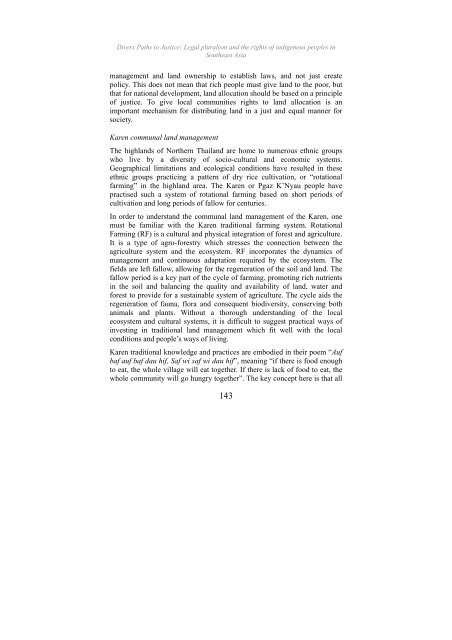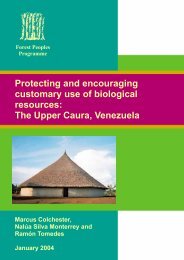Divers Paths to Justice - English - Forest Peoples Programme
Divers Paths to Justice - English - Forest Peoples Programme
Divers Paths to Justice - English - Forest Peoples Programme
Create successful ePaper yourself
Turn your PDF publications into a flip-book with our unique Google optimized e-Paper software.
<strong>Divers</strong> <strong>Paths</strong> <strong>to</strong> <strong>Justice</strong>: Legal pluralism and the rights of indigenous peoples inSoutheast Asiamanagement and land ownership <strong>to</strong> establish laws, and not just createpolicy. This does not mean that rich people must give land <strong>to</strong> the poor, butthat for national development, land allocation should be based on a principleof justice. To give local communities rights <strong>to</strong> land allocation is animportant mechanism for distributing land in a just and equal manner forsociety.Karen communal land managementThe highlands of Northern Thailand are home <strong>to</strong> numerous ethnic groupswho live by a diversity of socio-cultural and economic systems.Geographical limitations and ecological conditions have resulted in theseethnic groups practicing a pattern of dry rice cultivation, or “rotationalfarming” in the highland area. The Karen or Pgaz K’Nyau people havepractised such a system of rotational farming based on short periods ofcultivation and long periods of fallow for centuries.In order <strong>to</strong> understand the communal land management of the Karen, onemust be familiar with the Karen traditional farming system. RotationalFarming (RF) is a cultural and physical integration of forest and agriculture.It is a type of agro-forestry which stresses the connection between theagriculture system and the ecosystem. RF incorporates the dynamics ofmanagement and continuous adaptation required by the ecosystem. Thefields are left fallow, allowing for the regeneration of the soil and land. Thefallow period is a key part of the cycle of farming, promoting rich nutrientsin the soil and balancing the quality and availability of land, water andforest <strong>to</strong> provide for a sustainable system of agriculture. The cycle aids theregeneration of fauna, flora and consequent biodiversity, conserving bothanimals and plants. Without a thorough understanding of the localecosystem and cultural systems, it is difficult <strong>to</strong> suggest practical ways ofinvesting in traditional land management which fit well with the localconditions and people’s ways of living.Karen traditional knowledge and practices are embodied in their poem “Aufbaf auf baf dau hif, Saf wi saf wi dau hif”, meaning “if there is food enough<strong>to</strong> eat, the whole village will eat <strong>to</strong>gether. If there is lack of food <strong>to</strong> eat, thewhole community will go hungry <strong>to</strong>gether”. The key concept here is that all143
















